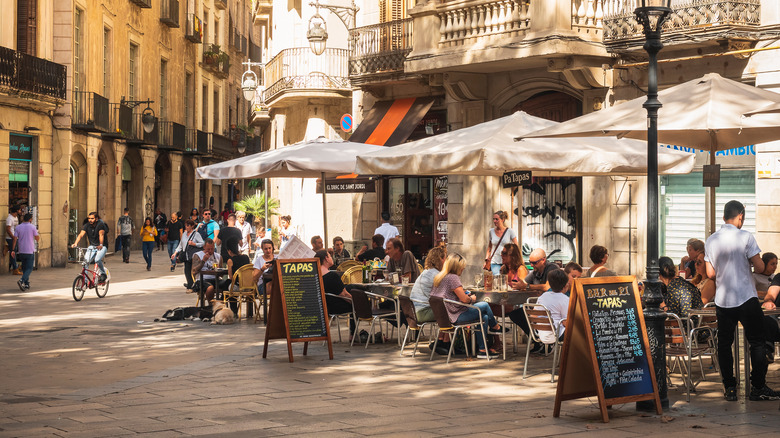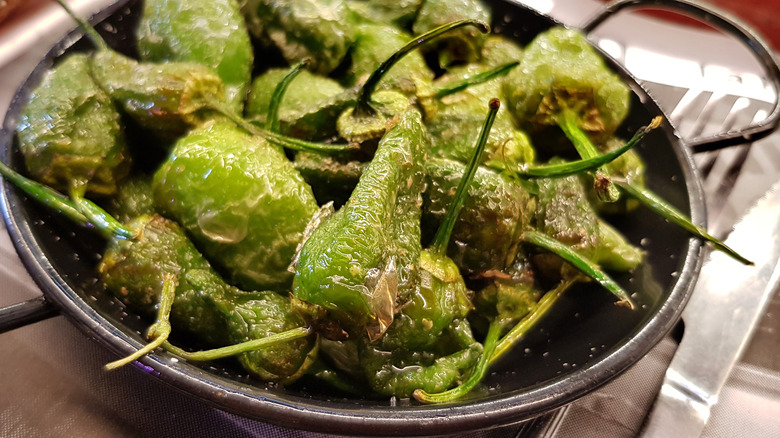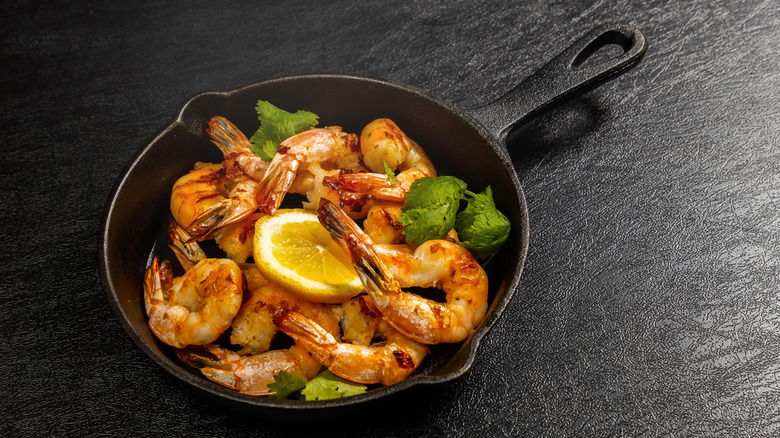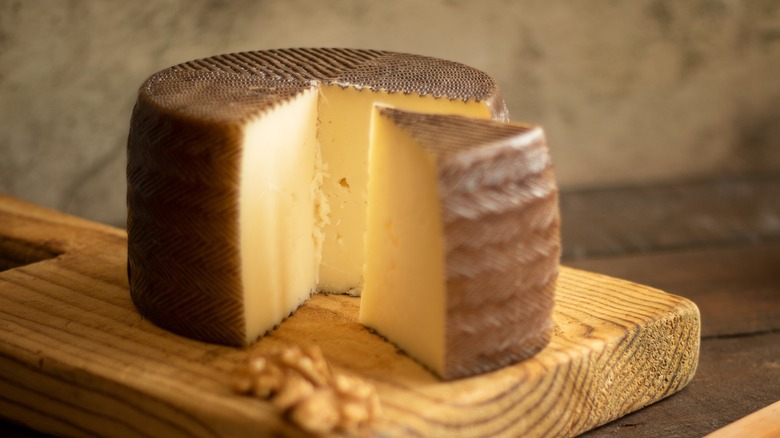The Undeniably Best Tapas To Order In Spain
Tapas are one of the most beloved aspects of Spain's cuisine. As reported by The Local, the practice of bars selling small portions of food alongside drinks began when Spaniards used small plates, pieces of bread, and even ham to cover their drinks to ensure no dust or flies fell into them. Today, tapas are so beloved that there are a plethora of "small plate" style bars and restaurants across the world, and even an annual world tapas day, per TH.
Culture Trip points out that, within Spain, there are numerous regional differences when it comes to tapas. In some areas like Granada tapas are served free with drinks, while in coastal cities like Valencia seafood plays a starring role. However, local culture also affects tapa type and availability significantly, most notably in the Basque Country where tapas are replaced by pintxos (via the Independent).
All of this suggests that when looking to order tapas in Spain, location should always be taken into account. That being said, here are some of the very best options that are widely available across the country, with a few regional specialties thrown in for good measure.
Tortilla
As the most popular tapa among Spaniards, and nearly half the population's favorite food, period (via The Local), the tortilla simply had to feature on our list. Yet, the widespread popularity of the tortilla does not mean that the dish is devoid of controversy, The Guardian reports. On the contrary, one of the most pressing questions facing Spanish cuisine in recent years has been whether the enigmatic tortilla de patatas should include onions or not.
A poll run by El Mundo, Spain's leading newspaper, found that over 70% of Spaniards preferred their tortilla with onion (via The Guardian). This goes against the common consensus in Betanzos, a town in A Coruña that is known for producing the country's best tortilla, according to GCiencia. In contrast, those in large metropolitan areas, such as Madrid, are much more used to the idea of tortilla with onions as Teresa Cuerda, co-owner of the popular bar Casi Dani explained to The Guardian. "Tortilla with onion has always been far more popular at Casa Dani than tortilla without onion," she said. "I'd say around 90% of our customers prefer their tortilla with onion [...] I think tortilla with onion tastes better because it makes it a bit juicier [...] But you don't really notice the onion in our tortilla and it doesn't dominate." Despite regional differences, this iconic tapa is served in bars across the country, making it a solid choice, even if only to see whether onions will be included or not.
Pimientos de Padrón
INaturalist reports that the chili pepper, Capsicum annuum, is native to the Americas. This might come as a surprise to those who know the peppers by their common name, pimientos de Padrón, the last word of which references a town in the northern province of A Coruña. According to Atlas Obscura, a group of monks brought pepper seeds back to Spain from the newly colonized South American continent during the 16th century. Once planted near the town of Padrón, these peppers slowly became genetically distinctive, resulting in the peppers we know today.
Pimientos de Padrón has since become one of Spain's simplest, yet most widely-consumed tapas dishes, being served throughout Spain, across Europe, and beyond. ABC News reports the dish has even become popular in Australia with farmers beginning to grow the Spanish crop in order to meet demand.
To serve, the peppers are fried until their skin is blistered and the flesh begins to collapse. They are then sprinkled with sea salt and occasionally a squeeze of lemon. This short ingredient list belies the dish's incredibly flavorful nature. This has led the peppers the basis of many a good tapas order.
Gambas al ajillo
As a country that borders two oceans and has over 3,500 miles of coastline (via La Moncloa) it should come as no surprise that seafood has always been an integral part of Spanish cuisine. The European Market Observatory for Fisheries and Aquaculture Products validates this fact by reporting that the average Spanish citizen eats more than 100 pounds of seafood per year. When it comes to tapas, one of the most popular and widely-available seafood dishes is gambas al ajillo, which translates to garlic prawns.
As highlighted in The Guardian, there are many ways to make gambas al ajillo, however, nearly all recipes will include lashings of garlic and the subtle presence of some chili spice. Another non-negotiable ingredient is olive oil, in which the prawns should be doused before cooking. The end result of this simple recipe is a sizzling cazuela full of subtly sweet, and incredibly tasty prawns.
Of course, it is best to order gambas al ajillo when you are in close proximity to the coastline, as the seafood in these locations should be among the country's best. However, you will be able to get good gambas al ajillo in pretty much every major city in Spain, especially the landlocked Madrid (via Culture Trip).
Patatas bravas
Another iconic, well-loved tapa is patatas bravas, fried potatoes covered with a rich tomato sauce and thick mayo. This dish has become a stalwart of bars and restaurants across the Iberian Peninsula thanks to its readily available ingredients and extreme popularity. Speaking to Inside Hook, Chef Ramón Martínez tried to explain why this simple dish has so many fans. "People just keep coming to order them," he said. "Because the mix of acidity of the tomato sauce, which is also a little sweet, and then you have the tangy and the slight bitterness of the aioli, because of the garlic, and then just the fried potatoes on top ... it's just a beautiful combination of textures and flavors."
As a dish that requires no specialty ingredients, the popular tapa is made across Spain, although individual restaurants often put their own twist on the dish. What's more, the simplicity of patatas bravas need not mean that it should only be paired with your standard caña. In fact, Wine Enthusiast makes a point of stating that patatas bravas work famously with a variety of wines, especially Tempranillo from Rioja, a fruity and spicy variety that stands up to the dish's punchy flavors.
Croquetas
Introduced to Spain by France, croquetas have become an iconic part of Spanish cuisine featuring in everything from weeknight dinners to celebratory feasts, and of course tapas, per Majorca Daily Bulletin. The versatility of croquetas can be partially attributed to their customizable nature. They can be made from either a thick bechamel sauce or mashed potatoes, while nearly anything can be used to stuff them. In short, there is a croqueta to suit every person and occasion.
While classic fillings such as ham and cheese abound, cooks — professional and otherwise — are increasingly turning to new and exciting flavors, as explained by food writer María José Sevilla in an interview with The New York Times. "It's become one of the most fashionable, and one of the most popular foods in Spain," she said. "At the end of the day, these beautiful foods do evolve in the hands of home cooks, chefs. They're making the most extraordinary, diverse croquetas."
As with all tapa, common croqueta types will vary from region to region. In coastal areas, you can expect to find croqueta stuffed with fish, such as cod, whereas meat will most likely dominate in restaurants throughout the country's interior. Whatever the flavor, croquetas promise to be a filling, indulgent tapa, and one that will please hungry customers of all ages.
Jamón Ibérico de bellota
As one of Spain's most prestigious food products, no tapas is complete without a few cuts of jamón Ibérico de bellota. Exclusively butchered from pata negra pigs raised on Spain's dehesa, jamón Ibérico de bellota is the ultimate in regional specialties and should be ordered at every opportunity. National Geographic notes that black label bellota is the premium grade Ibérico ham, indicating that the pigs lived on a diet of exclusively wild acorns, and spent the vast majority of their lives roaming Spain's dehesa. Unsurprisingly, this translates into ham that packs the most flavor, according to Club Enologique.
Fortunately, you will not be hard-pressed to find jamón Ibérico anywhere in Spain. Plates are served in pretty much every bar and restaurant across the country. While it may be tempting to save a few euros by ordering a lower grade — or different type — of ham, we would recommend only purchasing black label bellota as the difference in quality between this ham and lower grades is telling. This fact is reiterated by Chef Ferran Adrià in an interview with The New York Times. "Iberian pork meat is extraordinary," he noted. "There's nothing like it elsewhere in the world. There's a great difference between a superior ham and all the rest."
Manchego
Another of Spain's iconic food products is Manchego, a sheep's milk cheese made in a region of the country known as La Mancha (via BBC Good Food). The same publication goes on to note that Manchego has some distinctive characteristics, including a nutty flavor, mildly soft texture, and unique rind pattern. However, the most important facet of the cheese is that it is made with milk exclusively from the Manchego sheep, a species endemic to the area of La Mancha.
While Manchego is only made in La Mancha, it is sold widely across Spain. Just as with jamón Ibérico de bellota, Manchego can be used in a variety of tapas but is best served by itself. If you desire some variation, there are a few different types to try. These include fresco (aged for a few weeks), Semicurado (aged for up to 6 months), Curado (aged between six to 12 months), and Viejo (aged over a year), per Cheese Connoisseur. Semicurado and Curado are the most popular and thus commonly available, however, don't let this stop you from trying the tangier Viejo or the more buttery fresco if given the chance.
Gilda
As previously mentioned, it is not only individual dishes that change as you move across different Spanish regions but the very nature of tapas themselves. In the Basque country and neighboring northern regions, tapas are replaced by pintxos. The Basque pintxos differ from Castilian tapas in a number of ways. For example, they are seen as more inventive than tapas, are frequently served on a slice of bread, or are held together with a toothpick, according to San Sebastian Pintxos Tours.
One of the most iconic pintxos found across Northern Spain is gilda. This dish is made from green olives, cured anchovies, and pickled spicy peppers called guindilla, all skewered together on a toothpick, as noted by Smithsonian Folklife Festival. While basic in its construction, gilda has some lofty claims to fame, including being reported as the first pintxo ever invented and having a name that was inspired by the 1946 film of the same name, starring Rita Hayworth. Ties to popular culture aside, gilda is a quintessential pintxo, with salt, spice, and tang all combining to make a very refreshing mouthful. As such, gilda is a must-order if you find yourself in the north of Spain. However, you will be hard-pressed to find it outside of the Basque dominant regions.
Carrillada
The Spanish are unashamed of their love for pork, with it being the country's second most-consumed meat behind chicken (via Statista). And with access to dehesa-raised Iberian pork, it is no wonder why. While we will always encourage people to order as many plates of thinly-sliced, cured jamón as possible, it is important to note that there are many other ways that the Spanish enjoy their pork, most notably in the form of carrillada, pork cheeks braised in sherry, wine or port.
This delicious dish is made by frying the pig cheek, then simmering (along with onion, garlic, and spices) for a period of hours in the alcohol of choice, transforming this lesser-known cut of meat into something incredibly tender and flavorful. While the more squeamish may balk at the idea of eating cheek, the opportunity to enjoy one of Andalusia's most famous tapa should not be sniffed at, especially seeing as it gives you a less intimidating means of experiencing nose-to-tail eating, a practice Spanish chefs are notoriously adept at.
Boquerones
Despite being small, diminutive fish, anchovies pack an incredible amount of flavor. They are full of powerful umami, which, along with their oily texture and fishy taste, makes them delightful to eat. In Spain, the fish have proven to be incredibly popular in the country, selling more than 95 million kilograms of them in 2015 alone (via Statista).
When it comes to eating anchovies there are two main tapas dishes: boquerones en vinagre and boquerones fritos. Boquerones en vinagre — which means anchovies in vinegar — are the most popular form of anchovy tapa thanks to the sharp flavor and meat-like texture the fish takes on when marinated, per Oceana. In comparison, boquerones fritos are crispier and fattier having been made from anchovies that are covered in flour and deep-fried (via ArteCaravana).
The late 2010s saw some Spanish anchovy stocks collapse, bringing into question the sustainability of eating this famous Spanish tapa. However, Oceana reports that a science-based and fisherman-led approach in 2020 resulted in stocks replenishing at impressive rates. This means that Spanish-caught anchovies can now be enjoyed by all, safe in the knowledge that marine life is being properly cared for.
Ensalada Rusa
A salad popularized in the Soviet Union may not seem like an obvious candidate for one of the most popular tapa in Spain. However, ensalada rusa, otherwise known as Russian or Olivier salad, has an impressively global appeal. As highlighted by The Guardian, versions of this salad are popular across Europe, the Middle East, and South Asia.
Made from a mixture of root vegetables, including potatoes, eggs, animal protein such as ham, and a hefty helping of mayonnaise, ensalada Rusa does not fit the leafy, green preconception many have when they hear the word "salad." However, the dish has become widely popular in Spain thanks to its suitability for hot days. What's more, the cubed salad goes especially well with cold cuts of meat, and as such can easily be used to complement other tapas classics like jamón Ibérico. At the end of the day, ensalada rusa might not be the most authentically Spanish tapa you can enjoy in the country, but, it might just be one of the most satisfying.
Aceitunas
Spain is far and away the biggest producer of olives in the world, producing more than double that of second-place Italy, per FAO (via NationMaster). Unsurprisingly, olives — known as aceitunas in Spain — have a long culinary history in the Iberian Peninsula with Olives From Spain reporting that they have been a part of the Mediterranean peoples' diet for over 6,000 years. Today, olives are one of the most common tapas in Spain and are often served as a complimentary side when ordering drinks.
Andalucia.com reports that Spain alone is home to more than 250 varieties of olives. While this number is daunting, many are only used to make olive oil. When it comes to eating, a good variety to start with is empeltre, which is grown in and around the region of Aragon and known for its intense flavors, per Great British Chefs. However, you will most likely be served whichever variety of olives is grown locally. This means that while a dish of olives might be a common sight, the experience of eating them is anything but homogenous.
Chorizo a la sidra
We couldn't complete a list of tapas dishes without mentioning what is perhaps the country's most well-known food product, chorizo. This fiery, red sausage has captured hearts and stomachs across the globe thanks to its punchy flavors and iconic appearance. As such, we advise ordering chorizo at any opportunity you get. Mixing chorizo with cider — a lesser-known, but still excellent Spanish product (via Imbibe Magazine) — is one of the best ways to enjoy it.
The resulting dish, known as chorizo a la sidra, is a delicacy that was first created in the northern region of Asturias, Amigo Foods reports. The dish has now become widely available and is featured on the menus of numerous Spanish bars and restaurants thanks to its rich taste and simple preparation. Spanish cider is extremely unique and its inclusion in this dish adds a wholly new and unexpected dimension to the familiar chorizo. Consequently, we would strongly advise ordering chorizo a la sidra. If nothing else, you are being granted the privilege of enjoying two incredible Spanish food products for the price of one.













